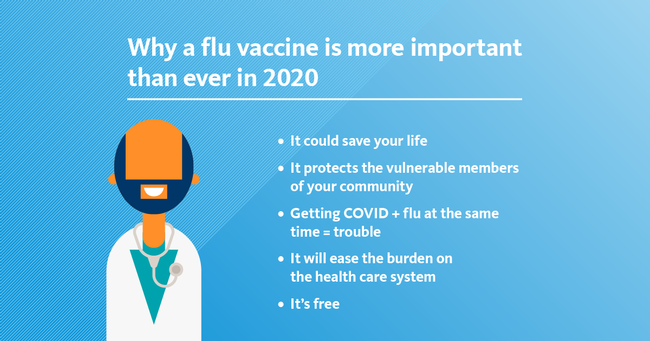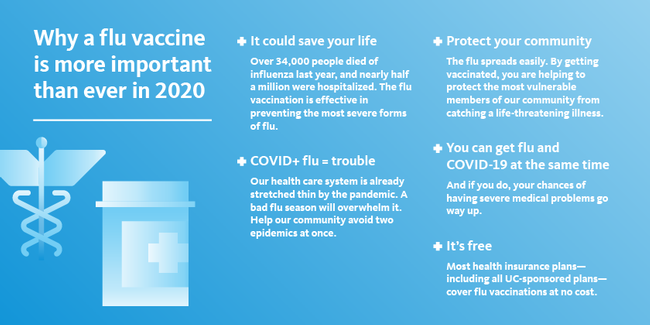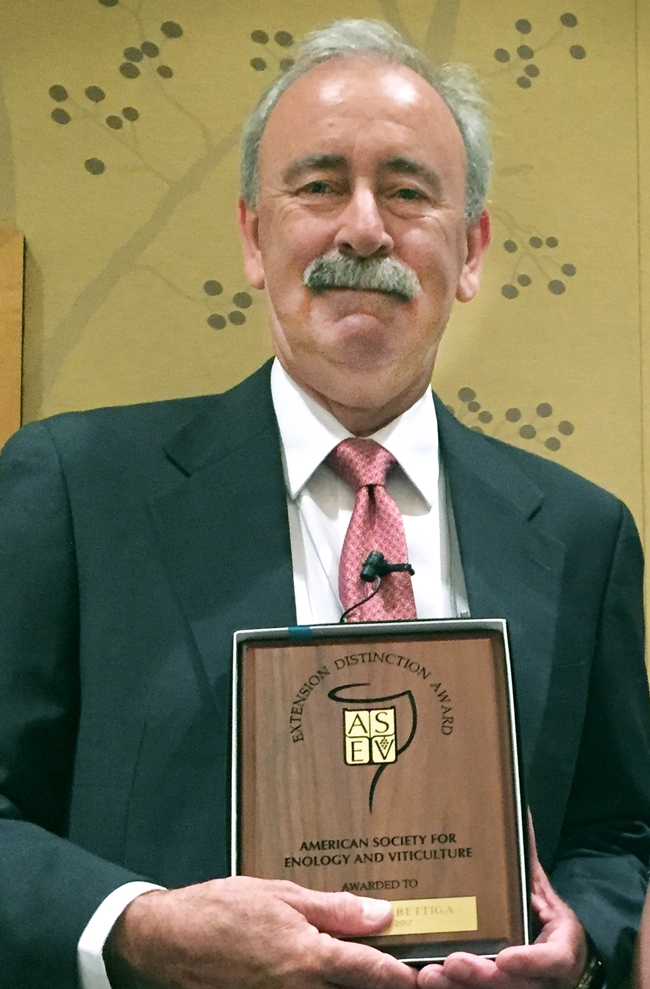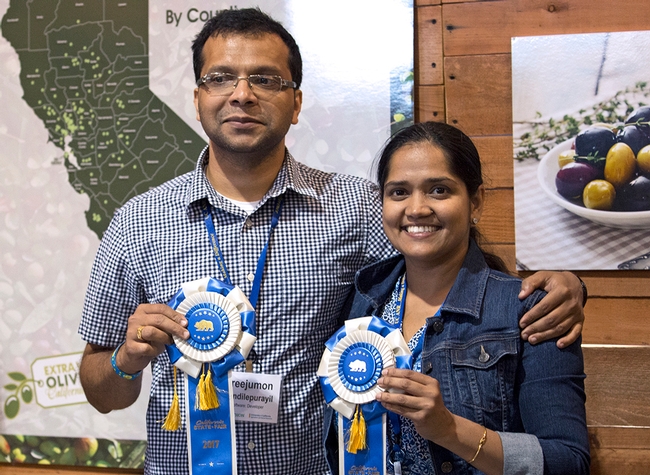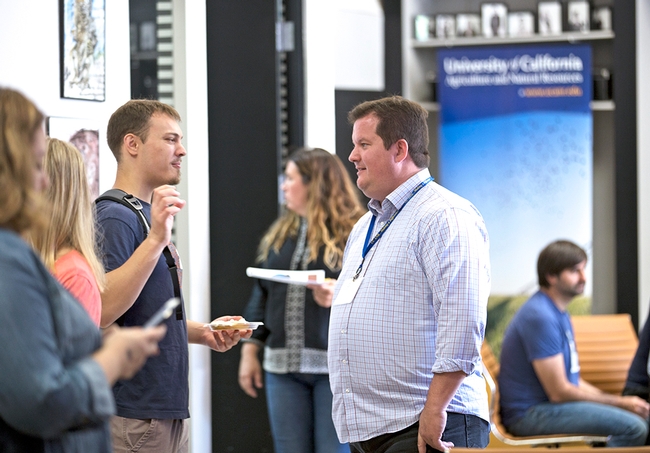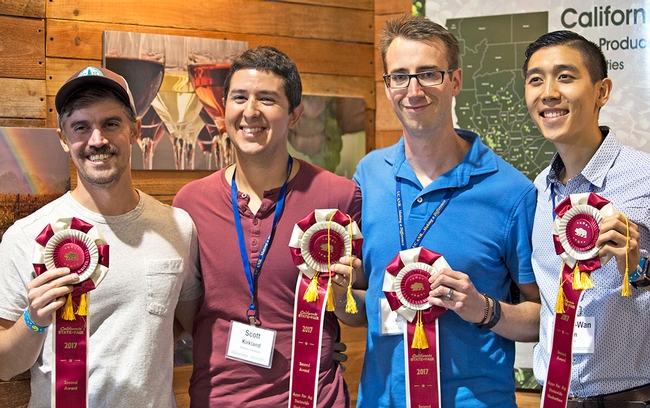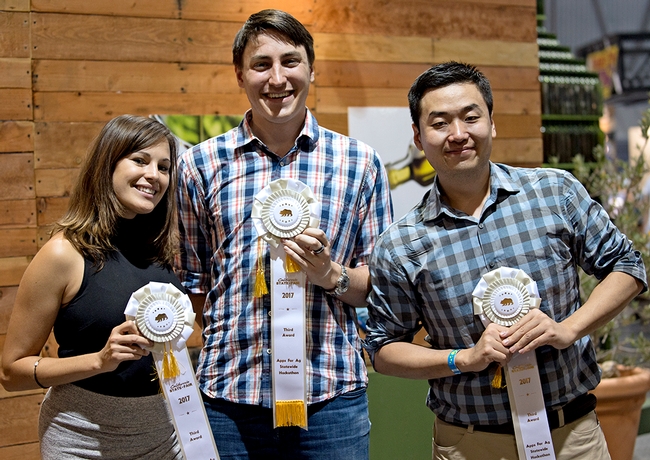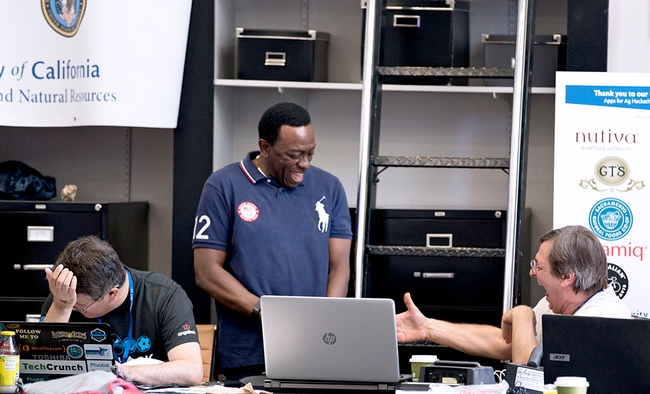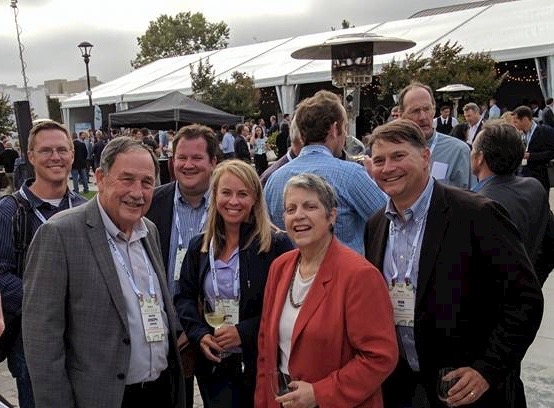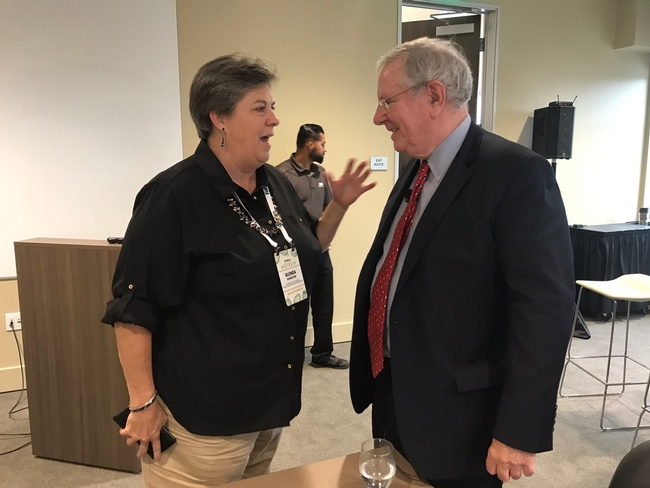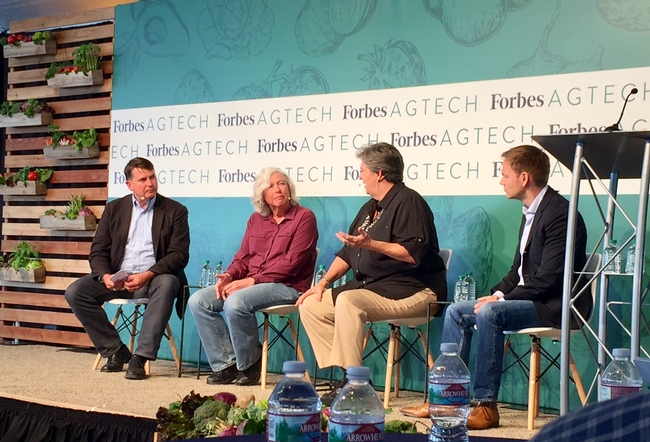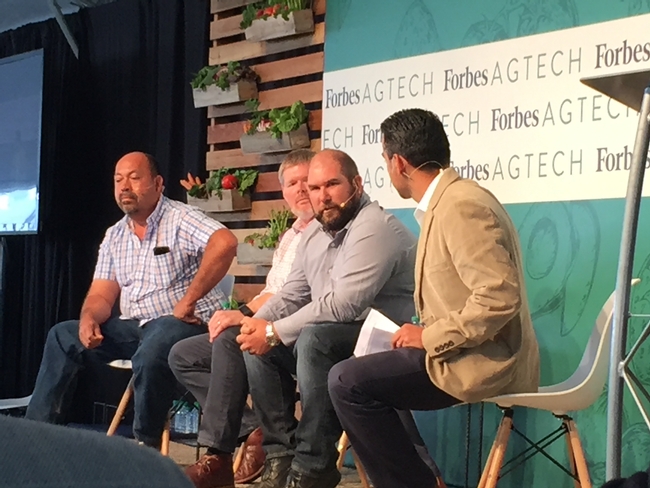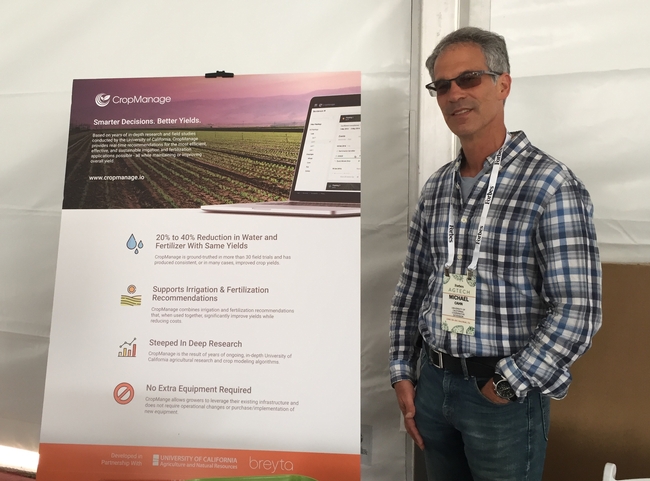Posts Tagged: flu vaccination
Getting a flu vaccine in 2020 is more important than ever
With the novel coronavirus still infecting thousands of people a day, public health officials worry that a bad flu season could overwhelm hospitals and clinics that are already stretched thin.
The best thing you can do to make sure that doesn't happen: Get a flu shot.
The flu shot is now widely available, and virtually all insurance plans cover the cost. Some health care providers are even offering the safety and convenience of getting vaccinated at an outdoor drive-up or walk-up location.
The life you save could be your own
If helping our overtaxed health care system isn't reason enough to get vaccinated, consider the fact that it could actually save your life. 34,000 people died of influenza during the 2018-2019 flu season and nearly half a million others were hospitalized.
Getting a flu vaccine is the most important thing you can do to protect yourself from flu and its most serious complications. And it could also help ensure that you don't contract COVID-19 and the flu at the same time.
Doctors don't yet know what will happen to patients with that kind of dual diagnosis, said UC San Francisco epidemiologist George Rutherford.
What is clear is that the flu and COVID-19 both target the lung, he said.
“And to the extent that the lungs are damaged by one disease and the other one comes along and damages it more, you can get into trouble faster,” he said.
He added that it's also known that influenza can make you more susceptible to infection by other pathogens. “In fact, a lot of the deaths of the 1918 flu pandemic were probably from staphylococcal pneumonia as a superinfection on top of influenza pneumonia,” he said.
Do it for your loved ones
Still not convinced that you should get a flu shot? Think about doing it for the people you love.
Flu is highly contagious, and particularly dangerous for the elderly, people with underlying health conditions, and children. The greater the number of people who get vaccinated, the better protected these vulnerable populations will be.
“If you get influenza, you may be putting your loved ones — the very young, the very old, such as your children, parents and grandparents — at risk,” said Charles Chiu, M.D., Ph.D., an infectious disease expert at UC San Francisco.
“I think it's important to realize that taking the vaccine is not just for you, it's also to prevent spreading the virus to others. So, on a community level, the more people that are vaccinated, the fewer overall cases we're going to get.
Still not sure about getting a flu vaccine this year?
This Q&A from Nina Bai and UCSF sets the record straight on common myths. Read their full article on the flu shot here.
In a typical flu season, less than half of Americans get a flu shot, putting themselves and their loved ones at risk of a preventable disease.
Some people may have doubts about vaccine efficacy. Others think the flu is no big deal. And during COVID-19, some worry about the risks of going to a doctor's office.
We asked the experts about these common concerns.
I'm not sure about getting a flu vaccine because …
1. Going to the doctor's office seems risky during COVID-19.
“The risk at a doctor's office is very likely to be much less than the risk of going out to a supermarket or a crowded location,” said Chiu. That's because health care workers are vigilant about taking the appropriate precautions. Most documented COVID-19 outbreaks have occurred in gatherings where people were not adhering to standard precautions like mask wearing and social distancing. “This is exactly the opposite of a controlled situation such as the doctor's office,” said Chiu.
Experts say local pharmacies are also safe settings to get a flu shot.
Like any activity during COVID-19, it's about balancing the risks and benefits. “The benefits of getting a vaccine far outweigh the very, very low risk of one visit to a doctor's office while wearing a mask and social distancing,” said Chiu.
2. I'm already social distancing and wearing a mask, so I won't catch the flu.
It's true that your risk of catching the flu is much less if you wear a mask and social distance one hundred percent of the time, said Chiu, but “we know that people get tired of these measures” and may not always be rigorous.
As colder weather sets in, more activities will move indoors where transmission is more likely. At the same time, more states may be opening up and lifting restrictions, more people will be going back to work and kids going to back to school. “Although the risks might be low now that people are still behaving, the worry is that it's going to change,” said Chiu. “It only takes one episode where you forget to wear your mask, or choose not to, that can put you and others at risk.”
3. I heard the flu season is going to be mild this year
It's true that Australia, where the flu season peaks from June to August, has so far seen a much milder flu season, but that's likely due to social distancing, travel restrictions, and a higher than usual vaccination rate.
Those factors may not translate to the colder temperatures and variable mitigation measures across the U.S. The risk will also fall disproportionately on essential workers who don't have the luxury of sheltering at home, said Chiu.
“My worry isn't that we're going to have an overwhelming flu season,” said Chiu, “My worry is that even a mild flu season may be enough to tip our health care system over the edge.”
4. The flu vaccine isn't very effective anyway.
The effectiveness of the flu vaccine varies from year to year depending on how closely we've guessed the strains, but we won't know the effectiveness of this year's vaccine until the flu season is over next spring, said Chiu. It's too early even to glean from the Southern hemisphere, which is still in its flu season.
“What's valuable about the vaccine is that even if it is, say, only 50 percent protective one year, it has been shown that getting the vaccine may decrease the severity of illness and your risk of being hospitalized for influenza,” said Chiu.
Besides the personal benefit, getting a flu vaccine also contributes to the wider public health effort. “I think it's important to realize that taking the vaccine is not just for you, it's also to prevent spreading the virus to others,” he said. “So on a community level, the more people that are vaccinated, the fewer overall cases we're going to get.”
5. I'm young and healthy, so the flu isn't dangerous for me.
“People die of influenza at all age groups,” said Rutherford. “It causes a lot of morbidity and mortality.”
“Even in someone who is young and healthy, influenza can put them out of work for one to two weeks because of the fever and overwhelming fatigue,” said Chiu. “It's not a disease that you want to get.”
Another reason for young people to get the flu shot, said Chiu, is to protect those who are more vulnerable. You can spread the virus to others even before you are overtly symptomatic. “If you get influenza, you may be putting your loved ones — the very young, the very old, such as your children, parents, and grandparents — at risk.”
6. The vaccine contains harmful chemicals and can cause disease.
“The components of a flu vaccine have been extensively studied and vetted by not only the CDC, but also the FDA, and the data show overwhelmingly that these vaccines are safe and effective,” said Chiu.
“Just like any vaccine, there's a possibility of some soreness or redness at the site of the shot, or low-grade fever and aches,” said Chiu. “But flu vaccines do not cause flu and they do not cause conditions like autism.”
Flu vaccination required for UC students, faculty and staff by Nov. 1
To support the health and well-being of UC students, faculty and staff and our communities, the University of California, in consultation with UC Health leadership, has issued a systemwide executive order requiring all members of the UC community to receive an influenza immunization before Nov. 1, 2020.
The executive order is an important proactive measure to help protect members of the UC community — and the public at large — and to ameliorate the severe burdens on health care systems anticipated during the coming fall and winter from influenza and COVID-19 illnesses.
In addition to protecting those on campuses and the surrounding communities, this requirement is designed to avoid a surge of flu cases at health care facilities across the state during the unprecedented public health crisis caused by the coronavirus pandemic.
According to the Centers for Disease Control & Prevention (CDC), flu vaccination is a safe and effective way to prevent millions of illnesses and thousands of related medical visits every year. In recent years, flu vaccinations have reduced the risk of flu-associated hospitalizations among older adults on average by about 40%. Flu vaccinations also protect those around us, including those who are more vulnerable to serious flu illness.
The executive order requires the vaccination for all faculty and staff who are working at a UC location. The university already has a clear policy on immunizations for students, and this action adds influenza to existing vaccination requirements for them, and extends the requirement to faculty and staff beyond those which presently exist for all UC health care workers.
A process will be put in place for faculty and staff to request medical exemptions. Requests for disability or religious accommodations will be handled through the interactive process consistent with existing location policies and procedures.
All UC medical plans which cover faculty, staff and students include coverage for flu vaccinations at no cost to those covered by the plan. In addition, for those without group health care coverage, all ACA-compliant health plans also cover flu vaccinations as part of a preventive care package that includes no copay.
The Centers for Disease Control and Prevention (CDC) is the best source for information on this year's flu vaccinations and when it would be available.
Flu vaccine FAQs
UCOP has published frequently asked questions concerning the 2020-21 UC influenza vaccination order at https://ucnet.universityofcalifornia.edu/coronavirus/frequently-asked-questions-for-employees-about-the-2020-21-uc-influenza-vaccination-order.html.
More information about the implementation of UC's requirement, and when the flu vaccination for 2020-21 is available, will be shared in the coming weeks.
Unauthorized survey
UCOP Communications has learned that an outside market research firm, Consumer Evaluation & Insights, recently sent a survey about UC's flu vaccination policy to a number of UC faculty and staff with the subject line “Share your opinion on the UC Flu Vaccine requirement.” Please be aware this survey was not authorized or commissioned by UC, and you are under no obligation to complete it.
Additionally, because data from this survey is being collected by an external organization, UC cannot make any assurances regarding the use, privacy or security of any information you provide.
Names in the News
Gibbs named major gifts director
Gregory Gibbs joined Development Services as director of major gifts on July 1. In this role, Gibbs heads the Major Gifts fundraising team on behalf of UCANR.
Gibbs joined the UC system in 2006 as development director for the UC Davis College of Engineering. He later assumed additional responsibility as senior director of Corporate Relations in the Engineering Dean's office. During his tenure at the UC Davis College of Engineering, Gibbs's team was responsible for raising over $90 million in donor funds for students, faculty, infrastructure and academic programs.
After graduating from the U.S. Air Force Academy, Gibbs began his career in 1985 as an officer in the U.S. Air Force, designing and analyzing satellite and missile systems to ensure national security. In 1992, he transitioned to the private sector and progressed through a series of technical sales and sales management positions of increasing responsibility at Ceridian Employer Services and Ascolta, a Cisco-certified Learning Solutions Partner focused on IT education. He subsequently relocated from Colorado to California to join the UC team.
His husband, Emilio Bejel, is a UC Davis distinguished professor in the Department of Spanish and Portuguese.
Gibbs is based in the ANR building at 2801 Second St. in Davis, and can be reached at (530) 750-1371, cell (530) 848-7860 and glgibbs@ucanr.edu.
ASEV honors Bettiga with Extension Distinction Award
Larry Bettiga, UC Cooperative Extension viticulture farm advisor, received the American Society for Enology and Viticulture's Extension Distinction Award at ASEV's 68th National Conference in Bellevue, Wash., on June 28. This honor recognizes a current extension educator for outstanding contribution to an extension program or the advanced translation of novel research findings into commercially applicable tools for enologists or viticulturists.
Bettiga's research focuses on the influences of cultural practices, rootstock and clonal selection, and canopy management on grapevine growth and productivity, and the use of integrated approaches to solve pest management problems in coastal winegrape production systems. Bettiga has been a UCCE viticulture farm advisor for the past 32 years and currently conducts applied research and extension education programs for winegrape growers in Monterey, San Benito and Santa Cruz counties.
While stationed at the UC Kearney Agricultural Research and Extension Center in Parlier, he evaluated cultural practices for table, wine and raisin grapes to improve yield and quality for grape production in the southern San Joaquin Valley. He also worked on pest management projects for grapes and tree nuts while based at the UC Cooperative Extension office in Tulare County.
Bettiga has authored and co-authored more than 400 technical articles, newsletters, research reports and abstracts. He has been an active member of ASEV since 1984, serving on the board of directors for five years, and was board president from 1999 to 2000.
Apps for Ag Hackathon winner uses AI to diagnose plant problems
For 48 hours, innovators and entrepreneurs at the Apps for Ag Hackathon labored over laptops at The Urban Hive in Sacramento before pitching their ideas to judges at the California State Fair. More than 40 people, some from as far as New York and Texas, competed for a $10,000 grand prize and assistance from UC Agriculture and Natural Resources to turn their ideas into commercial enterprises.
Ultimately Dr. Green, a mobile app to diagnose plant problems, took the top prize on Sunday (July 30). The second-place Greener app also helps people diagnose and treat plant diseases. Farm Table, an app that promotes agritourism, came in third place.
One goal of the hackathon was to produce solutions for military veterans who are becoming farmers. The U.S. Department of Veterans Affairs was a major sponsor of the event and leaders from Washington D.C. were on site all weekend participating.
“There was an amazing range of applications this year,” said Gabriel Youtsey, chief innovation officer.
Twelve teams pitched new ways to apply technology to improve the food system.
“There was an application to take a picture of a plant and it'll identify the plant disease – which can help anyone from backyard gardeners to professional growers – all the way to an application for community-supported fisheries, which helps fishermen better scale their businesses and allows for customers to get the freshest fish,” Youtsey said.
There was an app to match unemployed veterans with farm jobs, an online resource for bees, an app to simplify shipping logistics, an app for detecting mold on produce and many more solutions for food-related problems.
1st Place: Dr. Green
Figuring out why a plant is ailing can be time-consuming for a new farmer or backyard gardener. The plant doctor is always in with Dr. Green. The app created by Sreejumon Kundilepurayil and Vidya Kannoly of Pleasanton will help people identify crop diseases quickly through artificial intelligence and machine learning. The app can incorporate data from sensors monitoring temperature, light and soil moisture to alert growers to problems. Using a smart phone, backyard gardeners and growers can take a photo of plant symptoms and get a diagnosis or use the messaging feature to ask a question about symptoms and receive advice immediately.
Kundilepurayil and Kannoly won $10,000 and tickets to the UC Davis Food and Ag Entrepreneurship Academy, $3,000 worth of Google Cloud Platform credits, plus other resources to help the team start their venture.
2nd Place: Greener
Using a smart phone, home gardeners can take a photo of plant symptoms and quickly get a diagnosis and recommended integrated pest management treatment from the Greener app, created by Scott Kirkland, John Knoll and Shiang-Wan Chin of Davis and Calvin Doval of Oakland. They won $5,000 and $1,000 worth of Google Cloud Platform credits and other resources to help start their venture.
3rd Place: The Farm Table
The Farm Table app aims to make farms more economically sustainable and educate the public about food through agritourism. Heather Lee of San Francisco teamed up with Will Mitchell of Sacramento and Zhenting Zhou of New York City to create the agritourism app.
“We are making agritourism accessible to farmers by building a platform that's connecting visitors with farms,” said Lee. “This is going to help educate our communities on where their food comes from and create an additional revenue source for farmers.”
They won $2,500 and $1,000 worth of Google Cloud Platform credits and other resources to help start their venture.
Growing the pipeline of young innovators
Judges included Joshua Tuscher of the U.S. Department of Veterans Affairs; Robert Trice, investor and founder of The Mixing Bowl Hub; Jenna Rodriguez, product manager at Ceres Imaging; Ann Dunkin, chief information officer for the County of Santa Clara; and Jessica Smith, vice president of Strategic Partnerships at AngelHack.
Apps for Ag is a food and agriculture innovation event series hosted by UC ANR and sponsored by IO Labs, The Urban Hive, California Community Colleges and the California State Fair.
“We're growing the pipeline of young innovators, getting entrepreneurs and technologists interested in applying technology to solving problems in the food system,” said Youtsey, who led organization of the hackathon.
“UC ANR is the original innovation engine in food, agriculture and natural resources in California and has been so for over 100 years. This is just taking another spin at tackling innovation in food and agriculture through an innovative competition style format with technology,” he said.
Additional support for the hackathon was provided by Valley Vision, The Mixing Bowl, Farmer Veteran Coalition, AngelHack, Nutiva, Google Cloud Platform, Royse Law Firm, Hot Italian, GTS Kombucha, Startup Sac, AgStart, StartupGrind Sacramento, Future Food, Internet Society San Francisco Bay Chapter, Sacramento Food Co-op, Balsamiq and YouNoodle.
Tech meets ag at Forbes AgTech Summit in Salinas
“As we confront the problems in California today, we must ask ourselves, how will ag and tech solve these problems together? How can Salinas Valley and Silicon Valley work more harmoniously and how will the University of California's quest for new knowledge play a role?” said UC President Janet Napolitano to farmers, engineers, entrepreneurs and others attending the Third Annual Forbes AgTech Summit.
Silicon Valley, the birth place of high tech, converged with Salinas Valley, “the nation's salad bowl,” on June 28 and 29 in Salinas to explore opportunities to apply technology to agriculture's challenges. About 700 people participated in the invitation-only event, which was co-sponsored by the University of California and UC ANR.
“The Forbes AgTech Summit brings together individuals and institutions from two integral parts of California's economic engine — agriculture and technology,” Napolitano said. ”The two have historically remained on parallel paths, each fueling the state's growth, but rarely converging. Yet, this is a unique moment here in California, and we have a unique opportunity in this nexus of agricultural bounty and technological innovation.”
Steve Forbes, chairman and editor-in-chief of Forbes Media, told Farm to Table Talk podcast, “Knowledge comes from experimentation, constant discovery, which agriculture has been doing for well over 1,000 years. That pace in agriculture is increasing today. There's no reason why, if we don't do silly things, the world, even though population will grow by 2 billion in the next three decades, the world won't have sufficient food, more abundant and healthier food than we can even imagine today. Human ingenuity will do it.”
VP Glenda Humiston joined Sallie Calhoun, owner and manager of Paicines Ranch, and Trent McKnight, rancher and founder of Agricorps, to discuss challenges and opportunities to grow entrepreneurs in agriculture with moderator Rob Trice, co-founder and partner of The Mixing Bowl. McKnight said there is technology gap between rural and urban America. Humiston noted that poor access to high-speed broadband in rural regions could slow their adoption of technology.
In a four-minute video produced by Forbes, Humiston discusses challenges and opportunities for agriculture. She describes how The VINE, or The Verde Innovation Network for Entrepreneurship, is being launched by UCANR and led by Gabriel Youtsey, chief innovation officer, to cultivate regional innovation and entrepreneurship ecosystems in rural communities.
Between the rising cost of minimum wage, an aging working population and immigration crackdowns, farming is facing a worker shortage. Brian Antle of Tanimura & Antle, Dan Steere, co-founder and CEO of Abundant Robotics, and Javier Zamora, owner of JSM Organics, discussed with moderator David Mancera of Kitchen Table Advisors, how technology could perform work that people don't want to do. Antle pointed out that while machines can plant and cut, they cannot replace the judgment of skilled workers.
In her address, Napolitano explained UC's interest in agricultural technology.
“We started the UC Global Food Initiative three years ago to find scalable solutions to sustainably and nutritiously feed a growing world population — one that's expected to reach 8 billion people by 2025,” Napolitano said. “At the same time, for more than a hundred years, people at UC Agriculture and Natural Resources have equipped farmers across the state with the latest scientific and technological advances in agriculture.
“They connect cutting-edge innovation with the state's farmers, who produce half of the nation's fruit and vegetables and export food to countries around the world. And they are constantly generating and testing new ideas.”
See related news coverage:
Napolitano Says Ag Needs Technology
Greater collaboration between ag and tech coming
University of California kicks off Ag innovation program
Labor shortage in ag fueling technology

